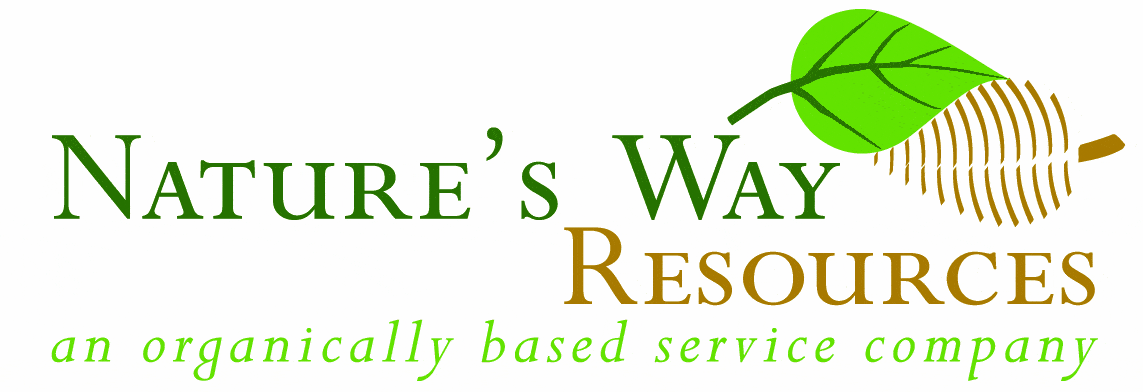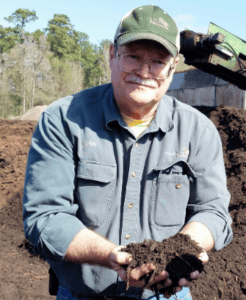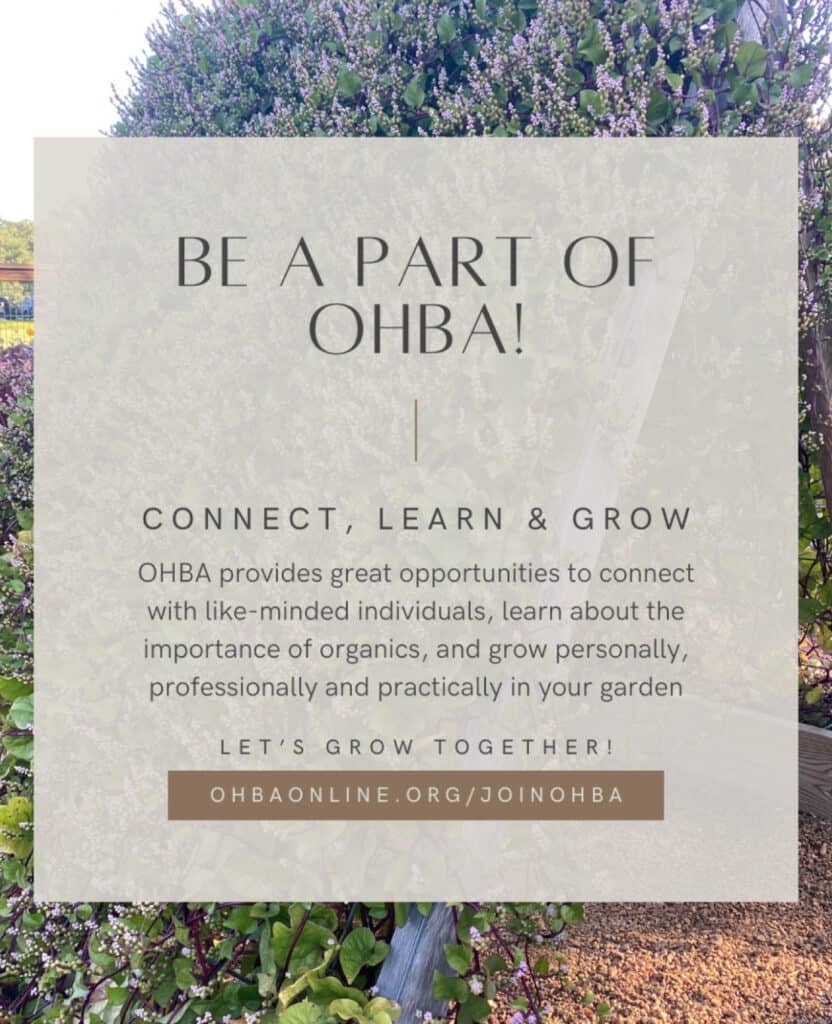 Nature’s Way Resources is proud to produce & email you this free weekly newsletter. We have no ads, but sponsors do graciously help support this project as a public service. Please note their names below & show your gratitude for this free service by patronizing their businesses! To become a sponsor, call (936) 273-1200
Nature’s Way Resources is proud to produce & email you this free weekly newsletter. We have no ads, but sponsors do graciously help support this project as a public service. Please note their names below & show your gratitude for this free service by patronizing their businesses! To become a sponsor, call (936) 273-1200
Nature’s Way Resources owner John Ferguson, “The Lazy Gardener” Brenda Beust Smith and Pablo Hernandez welcome your feedback and are so grateful to the many horticulturists who contribute their expertise
Click here to join our email list
CLICK HERE for PDFs OF PAST LG&F NEWSLETTERS
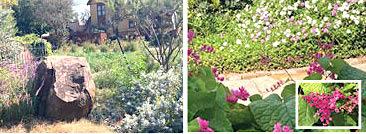
Above, KAREN GERLACH’s ‘natural’ garden photos
“I am so enamored with cottage gardens because I see in them,
a deep and ingrained pattern to human existence”.
— Donna L. Long, author, ‘Autumn in the Natural World’
COTTAGE GARDENING TIPS GOOD ROUTE FOR ALL OUR GARDENERS!
BY BRENDA BEUST SMITH
So many gardeners’ questions these days seem to come from newcomers and/or local folks new to gardening. The gardening advice offered below from Houston Rose Society (HRS) Rosarian and Harris County Master Gardener KAREN GERLACH is aimed at folks interested in creating a “cottage garden” look, in anticipation of HRS’s upcoming free virtual “Cottage Garden” seminar on this approach*. (See below)
But in reading it, I realized this is great advice for everyone new to gardening in our area as well as those of us puzzled by plants dying now or died this past summer. Bet one of her points is the reason. Love the way she divides advice into specific mistakes and fixes! If experienced gardeners can think of other common possible reasons to add, do share (lazygardenerbrenda@gmail.com).
FIRST THO: What’s the difference between an “English” garden and a “cottage” garden? Wikipedia’s perhaps overly-simplified definition: “Cottage is sort of the more wild, diverse, unkempt version . . . English would be more formal. English gardens utilize hedges and crisp, vertical evergreen accents to define spaces and punctuate certain areas.”
Karen takes a wonderfully simplified approach to common concerns:
1. CHOSE THE RIGHT PLANTS FOR OUR CLIMATE
Mistake: Selecting plants that are unsuitable for our hot, humid summers and mild winters.
Fix: Select plants that will thrive here! Look for native, drought-tolerant plants. Consider natives to our area!
2. PREPARE YOUR SOIL
Mistake: Our soil tends to be heavy clay. Remember that healthy roots equal healthy plants!
Fix: Fall and winter is the perfect time to amend your soil with organic material and aged manure to help your spring plants thrive. Cottage gardens tend to be densely planted so make sure the soil has all the nutrients to make your plants thrive! Don’t forget the mulch! This will help conserve water and help regulate the temperature extremes!
3. OVERCROWDING PLANTS
Mistake: We want instant gratification where we see dense, packed colorful blooms. So many folks plant their annuals and perennials too compactly. This leads to competition for food, water, and light.
Fix: Consider the full-grown size of your plants. Place them appropriately. Give them some space and they will thank you for it! You will have stronger and more disease resistant plants!
4.UNDERESTIMATING WATER NEEDS
Mistake: Summer heat and humidity can dry out plants faster than expected.
Fix: Water less often and deeply for deeper, stronger roots that will adapt to temperature extremes. Consider drip irrigation and soaker hoses.
5.NOT CONSIDERING SUN AND SHADE
Mistake: Planting sun-loving plants in too much shade or shade-loving plants in full sun.
Fix: Cottage gardens in the South get more sun intensity. Sun-loving flowers include black-eyed Susan, zinnias, and daylilies. More shade loving plants include hostas (check the variety heat tolerance), coleus and ferns.
6.IGNORING PEST & DISEASE MANAGEMENT
Mistake: The high humidity can lead to additional fungal disease and increased time for additional insect lifecycles.
Fix: Walk through and inspect your plants for pests like aphids, spider mites, and caterpillars. Nip these issues swiftly. There are many conventional and organic remedies. Hovever, make sure that pest issue are dealt with promptly. Make sure you identify the culprit and use as specific remedy as possible. No one needs a napalm approach in their garden. Be wise and judicious with your chemical agents.
7.OVERFERTILIZING
Mistake: More is not always better! Many folks use too much fertilizer, especially nitrogen-heavy fertilizers, which can encourage lush foliage but weak flowering.
Fix: Use a balanced, slow-release fertilizer to avoid overfeeding. Cottage gardens thrive on a balance between foliage and blooms.
8.NOT PLANNING FOR YEAR ROUND INTEREST
Mistake: Relying too much on spring blooms and forgetting year-round color and texture.
Fix: Ensure your cottage garden has plants that bloom at different periods throughout the year. Include foliage plants like evergreens, ornamental grasses, or shrubs for year-round interest.
9.IGNORING NATIVE PLANTS
Mistake: Not incorporating native plants, that are well adapted to the local climate.
Fix: Native plants, like coneflowers, black-eyed Susans, or butterfly weed, are more resilient and support local wildlife and pollinators.
10.CHOOSING INVASIVE PLANTS
Mistake: Using invasive species that can overtake and harm your local ecosystems.
Fix: Avoid using invasive plants, these can include English ivy, wisteria, and certain bamboo. Choose non-invasive varieties that satisfy your design goals and are friendly to your environment.

LIKE TO BE FIRST ON BLOCK? WHAT (THEY SAY) WILL BE HOT IN 2025 . . .
- Biodegradable pots, sustainable plant care products, and houseplants replacing cut flowers for gifting.
- Terrariums (above left): Miniature ones are seeing a resurgence; closed ones for tropical plants.
- Miniature Plants, a pop of greenery without taking up much space.
- Mountain Mint (Pycnanthemum muticum) (above right) is The Perennial Plant Association‘s “2025 Perennial Plant of the Year.” It will thrive, they say, as low as Zone 8 (Houston northward)
- Gardening for Better Health. How? See John’s column below.
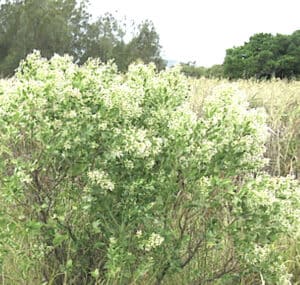
- SANDRA J. wonders about beautiful white blooming shrubs now in fields and edges of woods. A native worth planting at home? she asks. NO!!!!! Coyote brush (probably Baccharis halimifolia) might be female (white-white flowers) or male (grayish-white flowers). If you see one, you’ll probably see LOTS and that’s why they’re on all invasive plant lists now.
- OUR SINCERE CONDOLENCES on the passing of JO ANN ROGERS, former president of the Houston Federation of Garden Clubs, which so successfully unites so many of our neighborhood garden clubs and contributes so much the to beatification and health of so many gardens and landscapes. Thinking about joining a garden club? Check link above for area garden clubs near you. Great way to find out what works best in your area! Speaking of garden clubs . . .
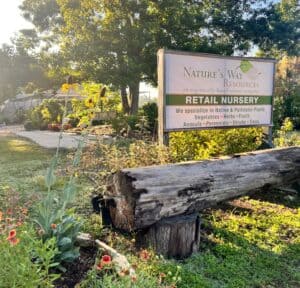 ATTN. GARDEN/PLANT GROUPS — In wake of Hurricane Beryl, Nature’s Way Resources offers free guided tours of NWR’s extensive nursery/soil/mulch facilities for garden clubs, plant societies and other plant-oriented, organized groups. As usual, NWR’s now-expanded meeting site is free to above groups. Reservations a must for both.
ATTN. GARDEN/PLANT GROUPS — In wake of Hurricane Beryl, Nature’s Way Resources offers free guided tours of NWR’s extensive nursery/soil/mulch facilities for garden clubs, plant societies and other plant-oriented, organized groups. As usual, NWR’s now-expanded meeting site is free to above groups. Reservations a must for both.
“LAZY GARDENER’S GUIDE” (PDF format) is emaild free. Request: lazygardenbrenda@gmail.com
Brenda Beust Smith’s column is based on her 40+ years as the Houston Chronicle’s “Lazy Gardener” column — lazygardenerbrenda@gmail.com Brenda’s column focuses ONLY on the Greater Houston Area
John’s Corner
NEWS FROM THE WONDERFUL WORLD
OF SOIL AND PLANTS # 308
Subject: Benefits of Gardening
Over the last few weeks several new studies have been released illustrating the benefits of gardening to our health. As doctor Mercola says, “Gardening isn’t just a hobby, it’s a powerful tool for enhancing your mental health and your quality of life.”
When one engages in gardening, you are not just planting seeds, you’re participating in an activity that blends physical exercise, recreation, and therapy. This pathway offers a unique combination to boost emotional, mental, and physical health.
“The hands-on nature of gardening gives one a sense of accomplishment and a connection with something greater. Whether nurturing plants in you yard or participating in a community garden, these activities foster a therapeutic environment that supports your mental resilience and overall life satisfaction”
The higher levels of well-being that one gets from gardening are strongly linked with a reduced risk of chronic diseases, cardiovascular ailments and diabetes.
Here are a few of the benefits of gardening:
- -regular gardening enhances one’s cognitive function
- people who regularly spend time in gardening report less symptoms of depression and anxiety
- people who garden regularly experience lower stress levels
- gardening helps us feel closer to nature
- gardening promotes positive emotions and creates a relaxed environment which lowers cortisol levels and reduce feelings of anxiety
- when folks engage in gardening, they incorporate more physical activity into their lives from digging, planting and weeding
- regular gardening helps improve cardiovascular health, strengthen our muscles, and increase our flexibility
- gardening helps with symptoms of arthritis by promoting join movement and reduces stiffness
- joining a community garden or garden club fosters a sense of belonging and mutual support
- gardening helps improve one’s sleep and has noticeable positive effects against daytime sleepiness, insomnia, and sleep apnea
- most of our gut microbes that play a large portion of our immune system, come from the soil. When one uses organic methods, we absorb these good microbes from breathing and touching the soil to help recharge our immune system
- people who garden regularly have 10 years longer lifespans than non-gardeners
- one method of getting antioxidant results is by walking barefoot on the soil, a process called “grounding or earthing”. It allows one to absorb large amounts of electrons (which have a negative charge) through our feet. The same benefit occurs when we plant or dig into the soil with our bare hands (another benefit of being a gardener). I know for me, it just feels good when I pick up a handful of rich fertile soil.
- many of the beneficial microbes in healthy soil help protect us against disease
- For example, if we have skin contact (no gloves) with the bacteria Mycobacterium vaccae
- may release serotonin, the chemical that helps relax us, wards off depression and makes us feel good. This is one reason that gardening helps folks recovering from addiction issues.
- Gardening exposes us to “greenness” which provides major health benefits. Numerous studies have shown that being exposed to greenness greatly reduces depression and anxiety
- Gardening exposes us to sunlight which provides many health benefits from the production of vitamin D, serotonin, endorphins, nitric oxide levels and increased mitochondrial energy from the ultraviolet B portion of sunlight:
- near infrared light helps with mitochondrial energy production and is used to maintain systemic equilibrium. It also helps cells in our retina for repair and regeneration
- Sunlight helps regulate circadian rhythm and is effective against SAD (seasonal affective disorder)
- The ultraviolet radiation stimulates our bodies epidermal cells to produce beta endorphins which help boost our mood. Other parts of the UVA radiation generates nitric oxide in our skin which produces many health benefits.
- Some of the UV radiation penetrates our skin actually kills many types of infections in our blood
- The infrared radiation in sunlight helps recharge our cellular batteries
- Lack of exposure to microbes in the soil when we are young makes us more susceptible to allergic diseases as we age. Exposure to soil microbes when we are young helps us build stronger immune systems that we will need as we age
- The soil is a major source of probiotics. The microbes in the soil become part of our intestines and skin and provide 80% of the strength of our immune system
A study from Washington State University has found that organic farming can feed the world. In addition, organic gardening or farming provides more benefits from environmental impact, economic viability, and social well-being. Other studies have shown that organically grown foods have higher nutrient density, more enzymes, vitamins, and other compounds required for good health.
Gardeners know that they feel better after having their hands in the soil. Microbes in the soil produce scents that make us feel better and stimulate our brain function. We are learning that regular contact with healthy soil, especially through gardening AND consuming produce that contains trace amounts of soil is a great way to strengthen our immune systems as it introduces healthy soil microbes to our bodies.
On a related topic, research at the University of California (published in Environmental Health Perspectives, 2018) has found that children raised in homes surrounded by more greenspace, tend to have more white and grey matter in their brains which leads to better cognitive function from better memories to better attention. These beneficial changes to their brains persist into adulthood.
As we garden, we smell many scents from our various plants which provide us with better health. For example, the new data suggests “that spearmint polyphenols may promote neurogenesis (the growth of new brain cells), while protecting existing neurons and boosting neurotransmitter levels.”
Vegetable gardening allows us to grow fruits and vegetable that taste better and are far more nutritious without the toxic cancer-causing chemicals on them.
If one uses toxic chemicals from artificial fertilizers to pesticides one does not obtain all these benefits.
We have all heard the proverb: healthy soils = healthy plants = healthy people
There is now a new corollary:
Eating junk food today = cancer, heart attacks, strokes, and diabetes in the future
SPONSORSHIP
If you are interested in becoming a sponsor, please contact us at 936-273-1200 or send an e-mail to: lazygardenerandfriends@gmail.com
ABOUT US
BRENDA BEUST SMITH WE KNOW HER BEST AS THE LAZY GARDENER . . . but Brenda Beust Smith is also:
- a national award-winning writer & editor
- a nationally-published writer & photographer
- a national horticultural speaker
- a former Houston Chronicle reporter
When the Chronicle discontinued Brenda’s 45-year-old Lazy Gardener” print column — started in the early ’70s as a fun side-project to reporting, it then ranked as the longestrunning, continuously-published local newspaper column in the Greater Houston area. The name, she says, is not just fun, it’s true. Brenda’s gradual sideways step from reporter into gardening writing led first to an 18-year series of when-to-do-what Lazy Gardener Calendars, then to her Lazy Gardener’s Guide book which morphed into her Lazy Gardener’s Guide on CD, which she now emails free upon request. Brenda became a Harris County Master Gardener and, over the years, served on theboards of many Greater Houston area horticulture organizations. She hosted local radio and TV shows, most notably a 10+-year Lazy Gardener specialty shows on HoustonPBS (Ch. 8) and her call-in “EcoGardening” show on KPFT-FM. For over three decades, Brenda served as Assistant Production Manager of the GARDEN CLUB OF AMERICA’S “BULLETIN” magazine. Although still an active broad-based freelance writer, Brenda’s main focus now is THE LAZY GARDENER & FRIENDS HOUSTON GARDEN NEWSLETTER with John Ferguson and Pablo Hernandez of Nature’s Way Resources. A native of New Orleans and graduate of St. Agnes Academy and the University of Houston, Brenda lives in Humble, TX, and is married to the retired Aldine High School Coach Bill Smith. They have one son, Blake. Regarding this newsletter, Brenda is the lead writer, originator of it and the daily inspiration for it. We so appreciate the way she has made gardening such a fun way to celebrate life together for such a long time.
JOHN FERGUSON
John is a native Houstonian and has over 35 years of business experience. He owns Nature’s Way Resources, a composting company that specializes in high quality compost, mulch, and soil mixes. He holds a MS degree in Physics and Geology and is a licensed Soil Scientist in Texas.
John has won many awards in horticulture and environmental issues. For years he represented the composting industry on the Houston-Galveston Area Council for solid waste. His personal garden has been featured in several horticultural books and “Better Homes and Gardens” magazine. His business has been recognized in the Wall Street Journal for the quality and value of their products. He is a member of the Physics Honor Society and many other professional societies. John is the co-author of the book Organic Management for the Professional.
For this newsletter, John contributes articles regularly and is responsible for publishing it.
PABLO HERNANDEZ Pablo Hernandez is the special projects coordinator for Nature’s Way Resources. His realm of responsibilities include: serving as a webmaster, IT support, technical problem solving/troubleshooting, metrics management and quality control. Pablo helps this newsletter happen from a technical support standpoint.
Download the Newsletter with Our Events Calendar Below!
